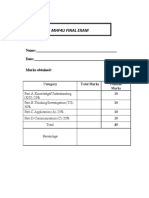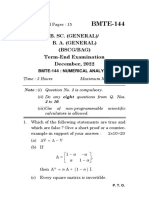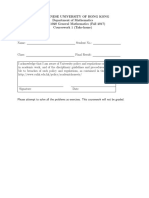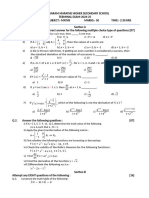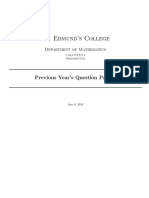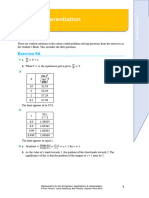BMTC 131 Solved Assignent
BMTC 131 Solved Assignent
Uploaded by
parveen TanwarCopyright:
Available Formats
BMTC 131 Solved Assignent
BMTC 131 Solved Assignent
Uploaded by
parveen TanwarOriginal Title
Copyright
Available Formats
Share this document
Did you find this document useful?
Is this content inappropriate?
Copyright:
Available Formats
BMTC 131 Solved Assignent
BMTC 131 Solved Assignent
Uploaded by
parveen TanwarCopyright:
Available Formats
IGNOU ALL SOLVED ASSIGNMENT PDF AVAILABLE ORDER ON WHATSAPP- 99922-90905
Assignment
Course Code: BMTC-131
Assignment Code: BMTC-131/TMA/2021-22
Maximum Marks: 100
PART – A (35 marks)
(Based on Blocks 1 and 2 of the course)
1. Which of the following statements are true, and which are false? Give reasons for your
answers in the form of a short proof or a counterexample. (10)
i) The function 𝑓: 𝑹 → 𝑹 defined as 𝑓(𝑥) = (x — 7) (x3 + 11)is an odd function.
5
ii) All the cube roots of 𝑖 in C are π
,
π π and π
90
5π 5π 𝑧1 = 𝑐𝑜𝑠 2 + i sin 2 𝑧2 = 𝑐𝑜𝑠 6 + i sin 6
𝑧 = 𝑐𝑜𝑠 + i sin .
3 6 6
-90
iii) If 𝑓(𝑥) = 2|𝑥 − 1| and 𝑔(𝑥) = 3𝑥 − 10, then 𝑓𝑜𝑔(1) = 12.
22
(3–x)
iv) The domain of the function f defined by 𝑓(𝑥) = √ is R-{2}.
(x–2)
1
v) (√2, 1, ) ∈ 𝑸 × 𝒁 × 𝑹.
9
99
2
2. a) If a, b and c are the roots of the equation x3-6x2+10x-6=0, find the values of
F-
1
a 2+b2+c2 and 1 + + 1. (4)
a b c
PD
b) Using the definition, show that lim(3x 5) = 1. (4)
x 2
ER
c) Find the square root of 1+i. (2)
1
3. a) Find the domain and range of the function f defined by 𝑓(𝑥) = . (3)
TH
1–sinx
1 + 2𝑥, 𝑥 ≤ 0
b) Let 𝑓(𝑥) = {3𝑥 − 2,0 < 𝑥 ≤ 1
LO
2𝑥2 − 1, 𝑥 > 1
i) Check whether f is discontinuous. If yes, find where?
AL
ii) Give a rough sketch of the graph of f. (5)
1
c) Express the function g, defined by g(x) = , as a composition of three
x+ x
functions. (2)
4. Find the following limits: (5)
x2+4x–1
(i) limx→2
x2–2x
1
(ii) limx→0 𝑥2 cos
x
Download All PDF - ignousolvedassignment.in
IGNOU ALL SOLVED ASSIGNMENT PDF AVAILABLE ORDER ON WHATSAPP- 99922-90905
PART – B (40 Marks)
(Based on Blocks 3 and 4 of the course)
5. a) If 𝑓(𝑥) = sin–1 𝑥, show that(1 − 𝑥2)𝑓''(𝑥) − 𝑥𝑓'(𝑥) = 0. Hence, prove that
𝑓(n+2) (0) = 𝑛2𝑓n(0). (4)
b) Find the maximum height of the curve 𝑦 = 4 sin 𝑥 − 3 cos 𝑥 above the x-axis. (3)
c) Verify Rolle’s theorem for f on [-1, 1] defined by (𝑥) = 𝑥4 − 4𝑥2 + 7 . (3)
6. a) Find the approximate value of 3√0.99 upto 4 places of decimal. (4)
5
b) Differentiate y w.r.t. x in the following cases: (6)
90
-90
i) 𝑦 = √sin(√𝑥)
ii) 𝑦 = 𝑒sinx + 𝑥𝑙𝑛𝑥
22
7. Which of the following statements are true and which are false? Give reasons for your
9
answers, in the form of a short proof or a counter example.
99
i) The function f defined by f(x) = tan(2x) is a periodic function with period π.
F-
ii) The function 𝑓: 𝑹 → 𝑹, defined by 𝑓(𝑥) = 1 − |𝑥| is differentiable at x=1.
PD
iii) The function 𝑓: [3,4] → 𝑹 defined by 𝑓(𝑥) = 𝑥2 − 𝑥 is monotonic in its domain.
iv) Every continuous function is differentiable.
ER
v) Every curve over R has a point of inflection. (10)
TH
8
8. Trace the curve 𝑦 = , and state all the properties you use to trace it. (10)
4–x2
LO
PART – C (25 Marks)
AL
(Based on Block 5 of the course)
9. Integrate the following functions w.r.t. x: (9)
i) x–1
∫ x3–x2–2x 𝑑𝑥
4
ii) ∫2 𝑥𝑙𝑛𝑥 𝑑𝑥
(cot—1 x)4
iii) ∫ 𝑑𝑥
1+x2
∞
10. (a) If 𝐼 = 𝑒–x𝑠𝑖𝑛n(𝑥)𝑑𝑥, prove that (1 + 𝑛2)𝐼 = 𝑛(𝑛 − 1)𝐼 𝑓𝑜𝑟 𝑛 ≥ 2. (5)
n ∫0 n n–2
Download All PDF - ignousolvedassignment.in
IGNOU ALL SOLVED ASSIGNMENT PDF AVAILABLE ORDER ON WHATSAPP- 99922-90905
b) Find the length of the curve given by 𝑥 = 𝑡3, 𝑦 = 2𝑡2 𝑖𝑛 0 ≤ 𝑡 ≤ 1. What is the
slope of the curve at t = ½. (5)
11. Which of the following statements are true? Give reasons for your answers, in the form
of a short proof or a counter example. (6)
π 2)
[∫ 𝑒2 cos t 𝑑𝑡] = −2𝑥𝑒
d 2 2(cos x
i)
dx x2
ii) |𝑥| is integrable in [-2, 2].
5
b 2–a 2
iii) ∫b 𝑥 𝑑𝑥 = .
90
a 2
-90
22
9
99
F-
PD
ER
TH
LO
AL
Download All PDF - ignousolvedassignment.in
IGNOU ALL SOLVED ASSIGNMENT PDF AVAILABLE ORDER ON WHATSAPP- 99922-90905
BMTC-131 : 2021-22
05
09
2-9
Ans. (i) 92
99
F-
PD
ER
TH
LO
AL
Download All PDF - ignousolvedassignment.in
IGNOU ALL SOLVED ASSIGNMENT PDF AVAILABLE ORDER ON WHATSAPP- 99922-90905
05
09
2-9
92
99
F-
PD
ER
TH
LO
AL
(ii)
Download All PDF - ignousolvedassignment.in
IGNOU ALL SOLVED ASSIGNMENT PDF AVAILABLE ORDER ON WHATSAPP- 99922-90905
05
09
2-9
92
99
F-
PD
ER
TH
LO
(iii)
AL
Download All PDF - ignousolvedassignment.in
IGNOU ALL SOLVED ASSIGNMENT PDF AVAILABLE ORDER ON WHATSAPP- 99922-90905
(iv)
05
09
2-9
92
99
F-
PD
ER
TH
LO
AL
(v) Rational numbers can be defined as the numbers which can be expressed in the form of p/q where
q not equal to zero and p and q are integers. root2/1 is not a rational number since root2 is not a
integer
Download All PDF - ignousolvedassignment.in
IGNOU ALL SOLVED ASSIGNMENT PDF AVAILABLE ORDER ON WHATSAPP- 99922-90905
Ans. (a)
05
09
2-9
92
99
F-
(b)
PD
ER
TH
LO
(c)
AL
Download All PDF - ignousolvedassignment.in
IGNOU ALL SOLVED ASSIGNMENT PDF AVAILABLE ORDER ON WHATSAPP- 99922-90905
05
09
2-9
92
99
F-
PD
ER
TH
LO
Ans. (a)
AL
Download All PDF - ignousolvedassignment.in
IGNOU ALL SOLVED ASSIGNMENT PDF AVAILABLE ORDER ON WHATSAPP- 99922-90905
05
09
2-9
92
B)
99
F-
PD
ER
TH
LO
AL
Download All PDF - ignousolvedassignment.in
IGNOU ALL SOLVED ASSIGNMENT PDF AVAILABLE ORDER ON WHATSAPP- 99922-90905
05
(c)
09
2-9
92
99
F-
PD
ER
TH
LO
AL
Ans. (i)
Download All PDF - ignousolvedassignment.in
IGNOU ALL SOLVED ASSIGNMENT PDF AVAILABLE ORDER ON WHATSAPP- 99922-90905
05
(ii)
09
2-9
92
99
F-
PD
ER
TH
LO
AL
PART – B (40 Marks)
(Based on Blocks 3 and 4 of the course)
Ans.(a)
Download All PDF - ignousolvedassignment.in
IGNOU ALL SOLVED ASSIGNMENT PDF AVAILABLE ORDER ON WHATSAPP- 99922-90905
05
09
2-9
92
99
F-
PD
ER
TH
(b)
LO
AL
Download All PDF - ignousolvedassignment.in
IGNOU ALL SOLVED ASSIGNMENT PDF AVAILABLE ORDER ON WHATSAPP- 99922-90905
(c)
05
09
2-9
92
99
F-
Ans.(a)
PD
ER
TH
LO
AL
Download All PDF - ignousolvedassignment.in
IGNOU ALL SOLVED ASSIGNMENT PDF AVAILABLE ORDER ON WHATSAPP- 99922-90905
(b) (i)
(ii)
05
09
2-9
92
99
F-
PD
ER
TH
Ans. (i)
LO
AL
(ii)
Download All PDF - ignousolvedassignment.in
IGNOU ALL SOLVED ASSIGNMENT PDF AVAILABLE ORDER ON WHATSAPP- 99922-90905
05
09
2-9
(iii)
92
99
F-
PD
ER
TH
LO
AL
(iv)
(v) In differential calculus and differential geometry, an inflection point, point of inflection, flex,
or inflection (British English: inflexion) is a point on a smooth plane curve at which the curvature
changes sign. In particular, in the case of the graph of a function, it is a point where the function
changes from being concave (concave downward) to convex (concave upward), or vice versa.
Download All PDF - ignousolvedassignment.in
IGNOU ALL SOLVED ASSIGNMENT PDF AVAILABLE ORDER ON WHATSAPP- 99922-90905
For the graph of a function of differentiability class C2 (f, its first derivative f', and its second
derivative f'', exist and are continuous), the condition f'' = 0 can also be used to find an inflection
point since a point of f'' = 0 must be passed to change f'' from a positive value (concave upward) to a
negative value (concave downward) or vise versa as f'' is continuous; an inflection point of the curve
is where f'' = 0 and changes its sign at the point (from positive to negative or from negative to
positive). A point where the second derivative vanishes but does not change its sign is sometimes
called a point of undulation or undulation point.
Ans.
05
09
2-9
92
99
F-
PD
ER
TH
LO
AL
Download All PDF - ignousolvedassignment.in
IGNOU ALL SOLVED ASSIGNMENT PDF AVAILABLE ORDER ON WHATSAPP- 99922-90905
05
09
2-9
92
99
F-
PD
ER
TH
LO
AL
Download All PDF - ignousolvedassignment.in
IGNOU ALL SOLVED ASSIGNMENT PDF AVAILABLE ORDER ON WHATSAPP- 99922-90905
PART – C (25 Marks)
(Based on Block 5 of the course)
Ans. (i)
05
09
2-9
92
99
F-
PD
ER
TH
LO
AL
(ii)
Download All PDF - ignousolvedassignment.in
IGNOU ALL SOLVED ASSIGNMENT PDF AVAILABLE ORDER ON WHATSAPP- 99922-90905
05
09
2-9
92
99
F-
PD
ER
TH
LO
AL
(iii)
Download All PDF - ignousolvedassignment.in
IGNOU ALL SOLVED ASSIGNMENT PDF AVAILABLE ORDER ON WHATSAPP- 99922-90905
05
09
2-9
92
Ans.
99
F-
PD
ER
TH
LO
AL
Ans.
Download All PDF - ignousolvedassignment.in
IGNOU ALL SOLVED ASSIGNMENT PDF AVAILABLE ORDER ON WHATSAPP- 99922-90905
Ans.
05
09
2-9
92
99
F-
PD
ER
TH
LO
AL
Download All PDF - ignousolvedassignment.in
You might also like
- (Maa 5.5-5.6) Monotony and ConcavityDocument46 pages(Maa 5.5-5.6) Monotony and Concavitytreecatzz953No ratings yet
- Limits and DerivativesDocument106 pagesLimits and Derivativesgulia grogersNo ratings yet
- MATH 2413 Calculus I Prerequisite ReviewDocument6 pagesMATH 2413 Calculus I Prerequisite ReviewAnaNo ratings yet
- Day 3 Reviewer 50 Questions Ver 1Document5 pagesDay 3 Reviewer 50 Questions Ver 1Darwin EugenioNo ratings yet
- BMTyv cybuC-131 (2)Document12 pagesBMTyv cybuC-131 (2)GG KingNo ratings yet
- June 21Document4 pagesJune 21Jai Kumar PandeyNo ratings yet
- December 2020Document4 pagesDecember 2020plant cancerNo ratings yet
- Assignment Booklet Assignment Booklet BMTC BMTC-131Document5 pagesAssignment Booklet Assignment Booklet BMTC BMTC-131parveen TanwarNo ratings yet
- June - 2021 BCS-12Document4 pagesJune - 2021 BCS-12lhdfohufiueiuNo ratings yet
- 12 Maths WT 1 QP 2024Document2 pages12 Maths WT 1 QP 2024moiiifitbituserNo ratings yet
- BCS 12Document4 pagesBCS 12Mess KNo ratings yet
- Holiday Assignment Xii 2024-25Document7 pagesHoliday Assignment Xii 2024-25satveepaniyalNo ratings yet
- IIT - JEE 2015 TW Test MARKS: 51 Time: 1Hr Topic: Function DATE: 13/03/15 Single Choice Questions (+3, - 1)Document4 pagesIIT - JEE 2015 TW Test MARKS: 51 Time: 1Hr Topic: Function DATE: 13/03/15 Single Choice Questions (+3, - 1)maverick3271No ratings yet
- First Periodical Test in Gen MathDocument5 pagesFirst Periodical Test in Gen Mathadlez nootib100% (1)
- Final Exam Mhf4uDocument6 pagesFinal Exam Mhf4uAS - 10SM 811497 Brampton Centennial SSNo ratings yet
- 06 Due 13th JanDocument9 pages06 Due 13th JanWinson LauNo ratings yet
- Bmte 144Document15 pagesBmte 144Njaan SnehamaakunnuNo ratings yet
- CU-2020 B. Com. (Honours) Advanced Business Mathematics-M2 Semester-V Paper-DSE-5.1 QPDocument2 pagesCU-2020 B. Com. (Honours) Advanced Business Mathematics-M2 Semester-V Paper-DSE-5.1 QPcg5187876No ratings yet
- CU-2020 B. Com. (Honours) Advanced Business Mathematics-M2 Semester-V Paper-DSE-5.1 QPDocument2 pagesCU-2020 B. Com. (Honours) Advanced Business Mathematics-M2 Semester-V Paper-DSE-5.1 QPAyan RoyNo ratings yet
- 9ABS302-Mathematics-III SET1Document1 page9ABS302-Mathematics-III SET1Avijit SamantaNo ratings yet
- MHF 4U Review Package - SurtiDocument8 pagesMHF 4U Review Package - SurtiWhimsical AlterationNo ratings yet
- 04.11.24 Senior Main Revision Sheet - FunctionsDocument3 pages04.11.24 Senior Main Revision Sheet - Functionsvshanmukh11No ratings yet
- MCS 302Document3 pagesMCS 302Saptadeep AcharjeeNo ratings yet
- Mathematics Question Paper 2017 BCA From D UniversityDocument18 pagesMathematics Question Paper 2017 BCA From D Universitywizyu freianNo ratings yet
- Inverse Trigonometric Functions - DPP 02 (Of Lec 03) - Lakshya JEE AIR Recorded 2025Document3 pagesInverse Trigonometric Functions - DPP 02 (Of Lec 03) - Lakshya JEE AIR Recorded 2025soumeshwar34No ratings yet
- 2020 F5 Adv. Math Test 1Document3 pages2020 F5 Adv. Math Test 1A.j. IssaNo ratings yet
- 11th Kalviexress STD Mathematics (EM) Public Exam Question Paper With Answers 2019Document8 pages11th Kalviexress STD Mathematics (EM) Public Exam Question Paper With Answers 2019sabaripattu20No ratings yet
- Mock Test-07 (Nda-2-2024)Document17 pagesMock Test-07 (Nda-2-2024)investmentinsight89No ratings yet
- 2021 Mfhs 3u Trial Paper 644536a377834Document11 pages2021 Mfhs 3u Trial Paper 644536a377834jesushumanchristNo ratings yet
- 14._Dec_2016 BCS-012 IGNOUAssignmentGuru.comDocument4 pages14._Dec_2016 BCS-012 IGNOUAssignmentGuru.combeatz6389No ratings yet
- C - Mathematics-XIIMat - 071Document4 pagesC - Mathematics-XIIMat - 071www.storytime1No ratings yet
- Functions 1Document7 pagesFunctions 1hannah10leahNo ratings yet
- MSM 111 - EXAM 2020-2021-Mathematical Methods IDocument5 pagesMSM 111 - EXAM 2020-2021-Mathematical Methods IWiza MulengaNo ratings yet
- Math Unit Test 2Document2 pagesMath Unit Test 2divya shreeNo ratings yet
- Baulkham Hills 2023 4U Trials & SolutionsDocument28 pagesBaulkham Hills 2023 4U Trials & Solutionsanew.name5245nNo ratings yet
- 1 - Relation and FunctionDocument16 pages1 - Relation and FunctionSAUMIL SINHANo ratings yet
- HOLIDAY ASSIGNMENT XII 2024-25 MATHEMATICSDocument7 pagesHOLIDAY ASSIGNMENT XII 2024-25 MATHEMATICSnaviii0711No ratings yet
- wt1 Class 12 201920Document3 pageswt1 Class 12 201920bharathsnair795No ratings yet
- MayombyaDocument4 pagesMayombyaYusuph Mndeme100% (1)
- U3 A2wsDocument7 pagesU3 A2wsarirubinsandersNo ratings yet
- Ilovepdf MergedDocument36 pagesIlovepdf MergedCristiano RonaldoNo ratings yet
- Classwork 1 PDFDocument15 pagesClasswork 1 PDFsamshamNo ratings yet
- Msm111-Tutorial Sheet TwoDocument3 pagesMsm111-Tutorial Sheet Twowilfredmukonde1905No ratings yet
- 12th MathsDocument4 pages12th Mathspoojabhagwat894No ratings yet
- MTE 02 English January 2022 December 2022Document36 pagesMTE 02 English January 2022 December 2022ArunNo ratings yet
- Function PDFDocument80 pagesFunction PDFarchit jain123No ratings yet
- Mat183 - 2012, JunDocument5 pagesMat183 - 2012, Junawg azhimNo ratings yet
- Bachelor of Computer APPLICATIONS (B. C. A.) (Revised) Term-End Examination December, 2020Document4 pagesBachelor of Computer APPLICATIONS (B. C. A.) (Revised) Term-End Examination December, 2020RabynNo ratings yet
- CalculasDocument2 pagesCalculaskaveen danikaNo ratings yet
- BCS-012 - Compressed1Document4 pagesBCS-012 - Compressed1otuneschannelNo ratings yet
- XI Maths UT-1 KVSTPDocument2 pagesXI Maths UT-1 KVSTPlakhanpal747No ratings yet
- Calculus I Question Paper (Descriptive)Document12 pagesCalculus I Question Paper (Descriptive)Darren OnielNo ratings yet
- N.B: Answer Six Questions, Taking Three From Each SectionDocument2 pagesN.B: Answer Six Questions, Taking Three From Each SectionRakib HasanNo ratings yet
- Mathematics (Advanced) : Practice PaperDocument12 pagesMathematics (Advanced) : Practice PaperGhoulGhostGGNo ratings yet
- G11, Christmas WorksheetDocument3 pagesG11, Christmas Worksheet2ppbgk2wnrNo ratings yet
- Math T (T1) Chapter 1Document4 pagesMath T (T1) Chapter 1BryanLeeChienYungNo ratings yet
- Mathematics III May2004 or 320360Document2 pagesMathematics III May2004 or 320360Nizam Institute of Engineering and Technology LibraryNo ratings yet
- Tutorial 1Document3 pagesTutorial 1Dank FyNo ratings yet
- Bachelor of Computer Applications (BCA) (Revised) Term-End Examination December, 2017Document5 pagesBachelor of Computer Applications (BCA) (Revised) Term-End Examination December, 2017krishan murariNo ratings yet
- B.Sc. Degree Examination, 2010: 730. Analysis - IiiDocument2 pagesB.Sc. Degree Examination, 2010: 730. Analysis - IiiRadhaNo ratings yet
- Mathematic Question Paper Set ADocument4 pagesMathematic Question Paper Set AADITHYA SUJINo ratings yet
- Practice Paper 01-11-2021fDocument6 pagesPractice Paper 01-11-2021frakshitk023No ratings yet
- De Moiver's Theorem (Trigonometry) Mathematics Question BankFrom EverandDe Moiver's Theorem (Trigonometry) Mathematics Question BankNo ratings yet
- BEVAE181 Solved AssignmentDocument32 pagesBEVAE181 Solved Assignmentparveen TanwarNo ratings yet
- Assignment Booklet BMTC-132: ST STDocument5 pagesAssignment Booklet BMTC-132: ST STparveen TanwarNo ratings yet
- BGGCT 132 English QuestionDocument3 pagesBGGCT 132 English Questionparveen TanwarNo ratings yet
- Assignment Booklet: Electricity and MagnetismDocument4 pagesAssignment Booklet: Electricity and Magnetismparveen TanwarNo ratings yet
- Tma, BPHCT-131 E, 2021-2022Document4 pagesTma, BPHCT-131 E, 2021-2022parveen TanwarNo ratings yet
- Haryana District MapDocument8 pagesHaryana District Mapparveen TanwarNo ratings yet
- Recruitment Selection at Big BazaarDocument70 pagesRecruitment Selection at Big BazaarRAJ KUMAR MALHOTRANo ratings yet
- sUMMER INTERNSHIP PDFDocument6 pagessUMMER INTERNSHIP PDFparveen TanwarNo ratings yet
- APPC 1.3-1.1 Review StationsDocument16 pagesAPPC 1.3-1.1 Review StationsRaad Al-Shaikh MD JDNo ratings yet
- 12CMT - Differentiation and Integration Daily PlannerDocument6 pages12CMT - Differentiation and Integration Daily PlannerRiya PatelNo ratings yet
- PDM Meoe07 Unit III Part IDocument36 pagesPDM Meoe07 Unit III Part IRohith KademaneNo ratings yet
- Mathematics l5 Marking GuidesDocument8 pagesMathematics l5 Marking Guidesiragaba69k100% (1)
- SL - Chapter - 9 - Worked - Solutions MATH IBDocument18 pagesSL - Chapter - 9 - Worked - Solutions MATH IBvalkyovaemmabesstNo ratings yet
- 04 - Curve SketchingDocument8 pages04 - Curve Sketchingtranquil_452889939No ratings yet
- Week 8 Differential Calculus With Analytic GeometryDocument26 pagesWeek 8 Differential Calculus With Analytic GeometryPaul John PanganibanNo ratings yet
- AAHLDocument4 pagesAAHLjoseph ronggurNo ratings yet
- ATAR Methods Revision Booklet 2022Document44 pagesATAR Methods Revision Booklet 2022josh soonNo ratings yet
- AP Calc AB 4.1-4.3 WS PacketDocument44 pagesAP Calc AB 4.1-4.3 WS PacketDavid Joseph100% (1)
- Kami Export - XII Lab Manual 1-10 Answer KeyDocument27 pagesKami Export - XII Lab Manual 1-10 Answer Keyjeromeallwin2007No ratings yet
- (Maa 5.13) More DerivativesDocument18 pages(Maa 5.13) More Derivativesdhruvkhera2No ratings yet
- Mathematics P1 May 2022Document24 pagesMathematics P1 May 2022tupanancedisa45No ratings yet
- Calculus Paper-2-1: (261 Marks)Document55 pagesCalculus Paper-2-1: (261 Marks)Parikshit goyaniNo ratings yet
- 12th Ex.7.9 NotesDocument10 pages12th Ex.7.9 Notesanwar7984023757No ratings yet
- Type 1 Type 2 Type 3 Type 4Document1 pageType 1 Type 2 Type 3 Type 4Giuseppe AdilNo ratings yet
- Grade 12 Differentiation CHPT 7 & 8Document60 pagesGrade 12 Differentiation CHPT 7 & 8Sri Devi NagarjunaNo ratings yet
- Lesson 4 Polynomial Curves Tangents and Normal To Plane CurvesDocument57 pagesLesson 4 Polynomial Curves Tangents and Normal To Plane CurvesSardoma, Lawrence A.No ratings yet
- Differentiation ApplicationDocument16 pagesDifferentiation ApplicationSujon ShikderNo ratings yet
- Concavity AND Point of InflectionDocument4 pagesConcavity AND Point of InflectionIrene Bal-iyang DaweNo ratings yet
- Differential Calculus PDFDocument27 pagesDifferential Calculus PDFVen Jay Madriaga TabagoNo ratings yet
- 2008 Multiple ChoiceDocument29 pages2008 Multiple Choicejakob fajitNo ratings yet
- Mock Examination - MathematicsDocument18 pagesMock Examination - MathematicsReem RodriguezNo ratings yet
- Curve TracingDocument82 pagesCurve TracingDr-Preeti JainNo ratings yet
- Answer Key HW3Document4 pagesAnswer Key HW3Arlan RodrigoNo ratings yet
- AP Calculus BC Syllabus HHSDocument9 pagesAP Calculus BC Syllabus HHSBhavnaNo ratings yet
- Mathematics and Physics For Chemists 1.: R.L.JacobsDocument69 pagesMathematics and Physics For Chemists 1.: R.L.Jacobseric simNo ratings yet














